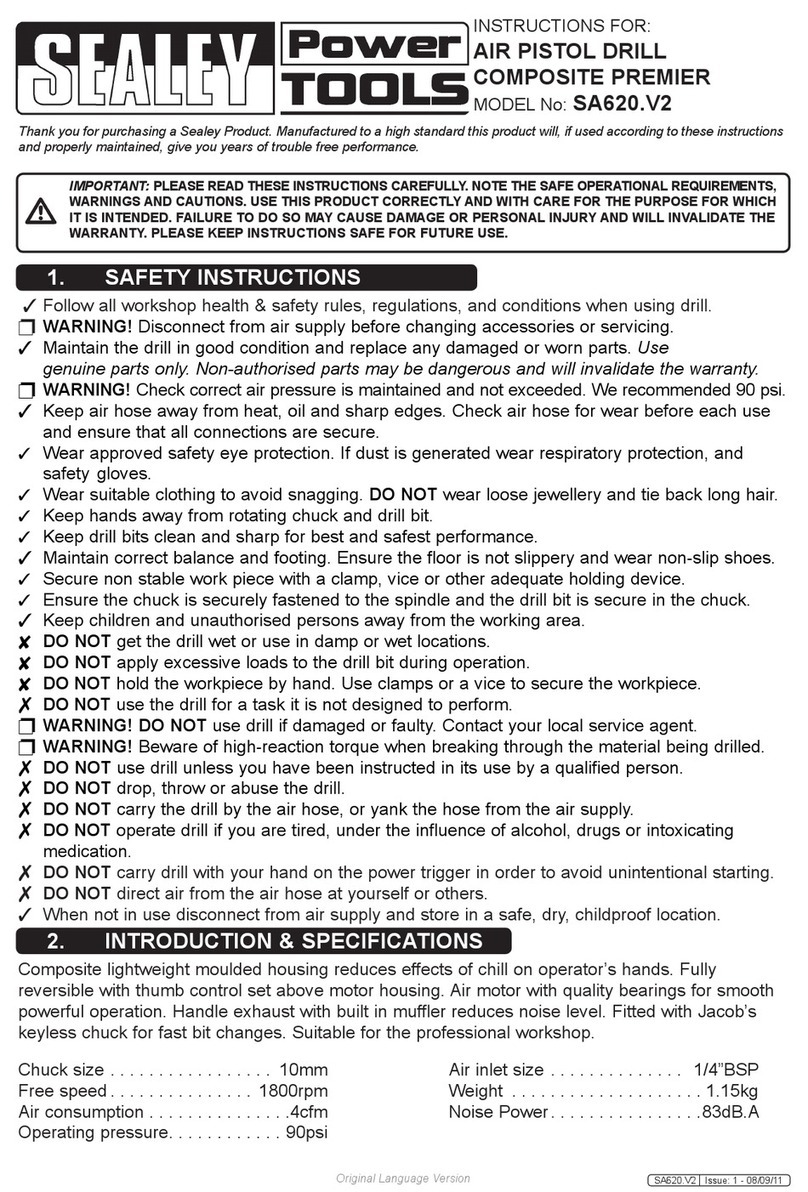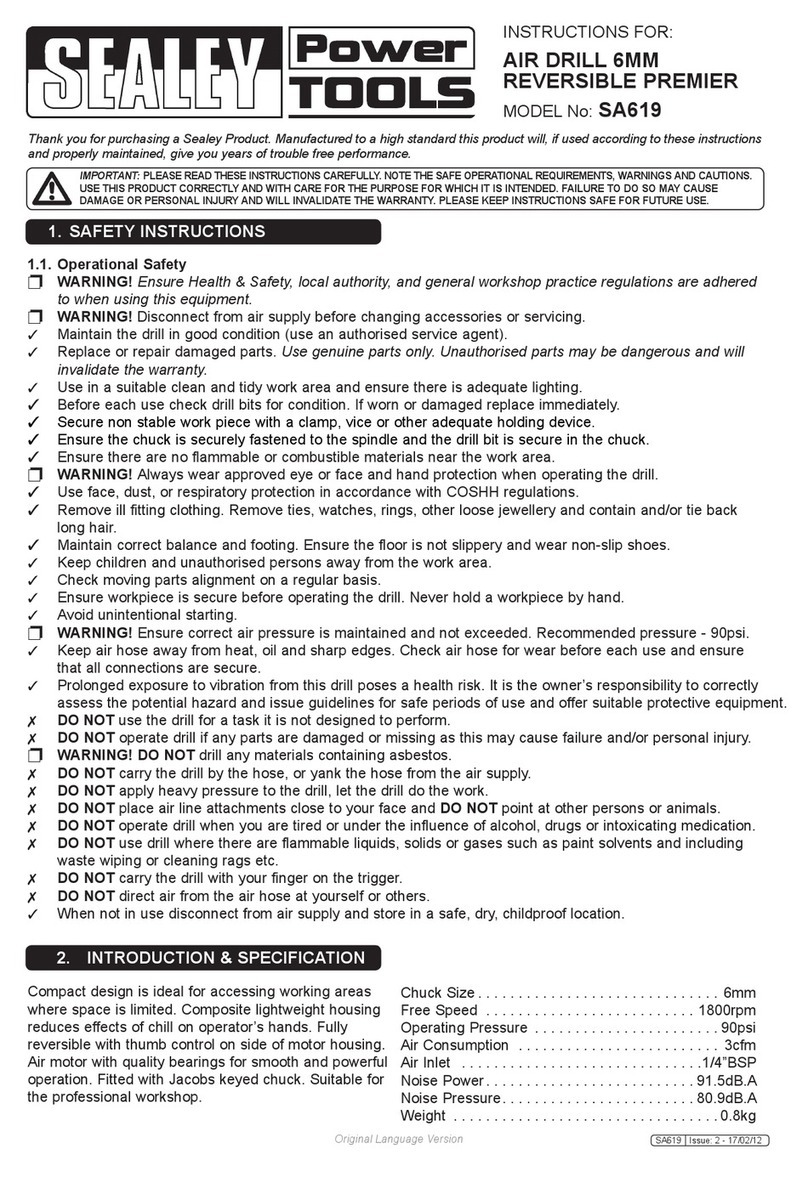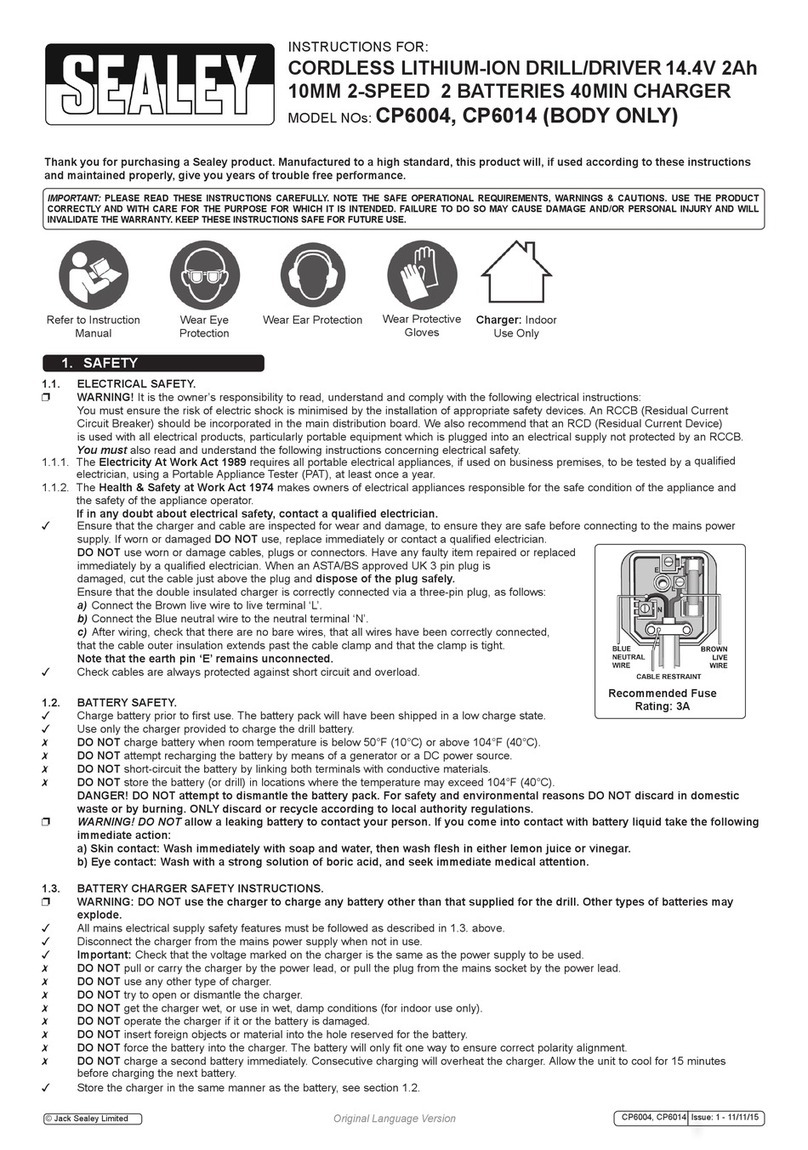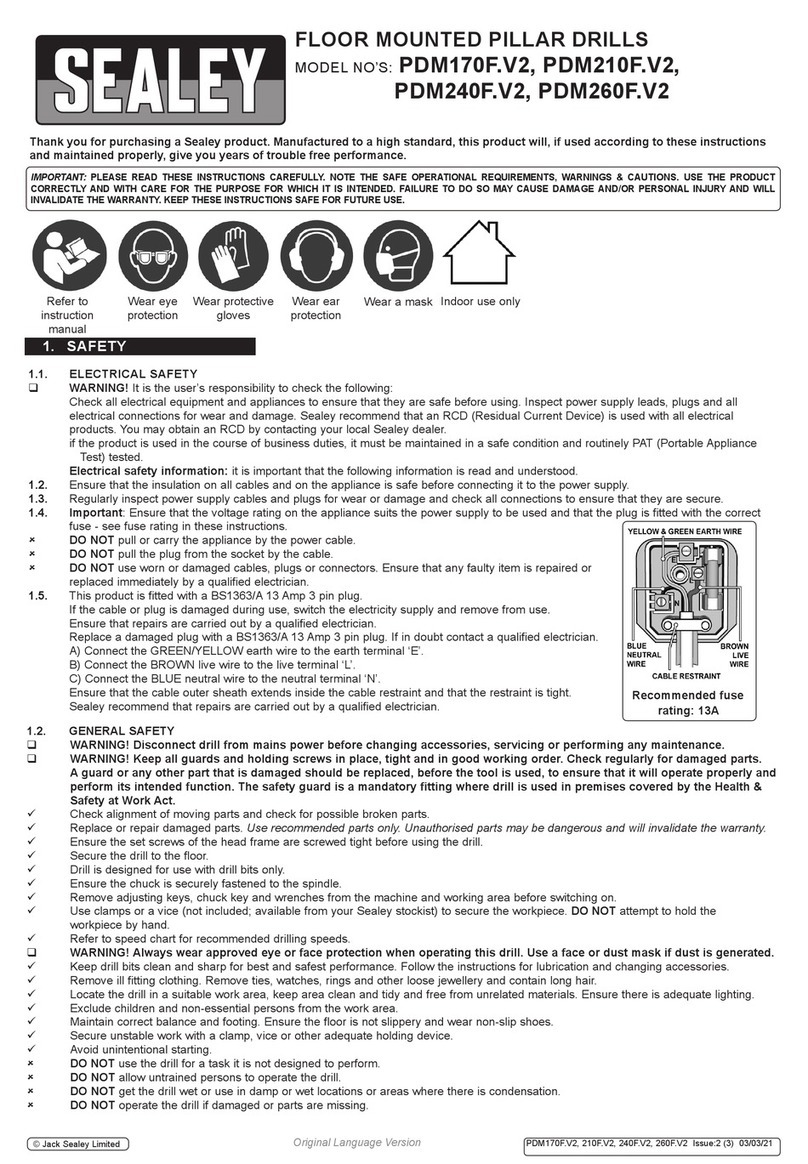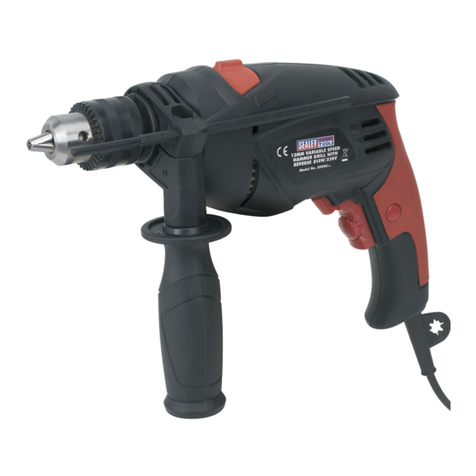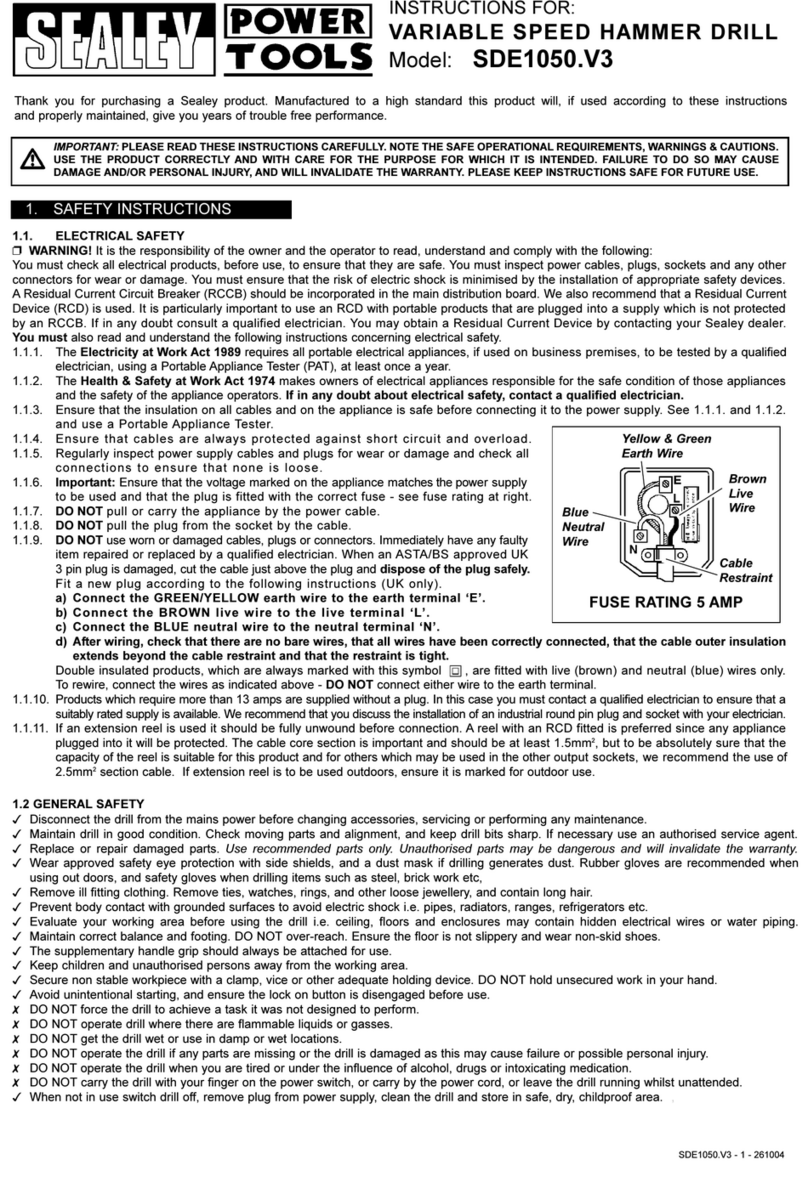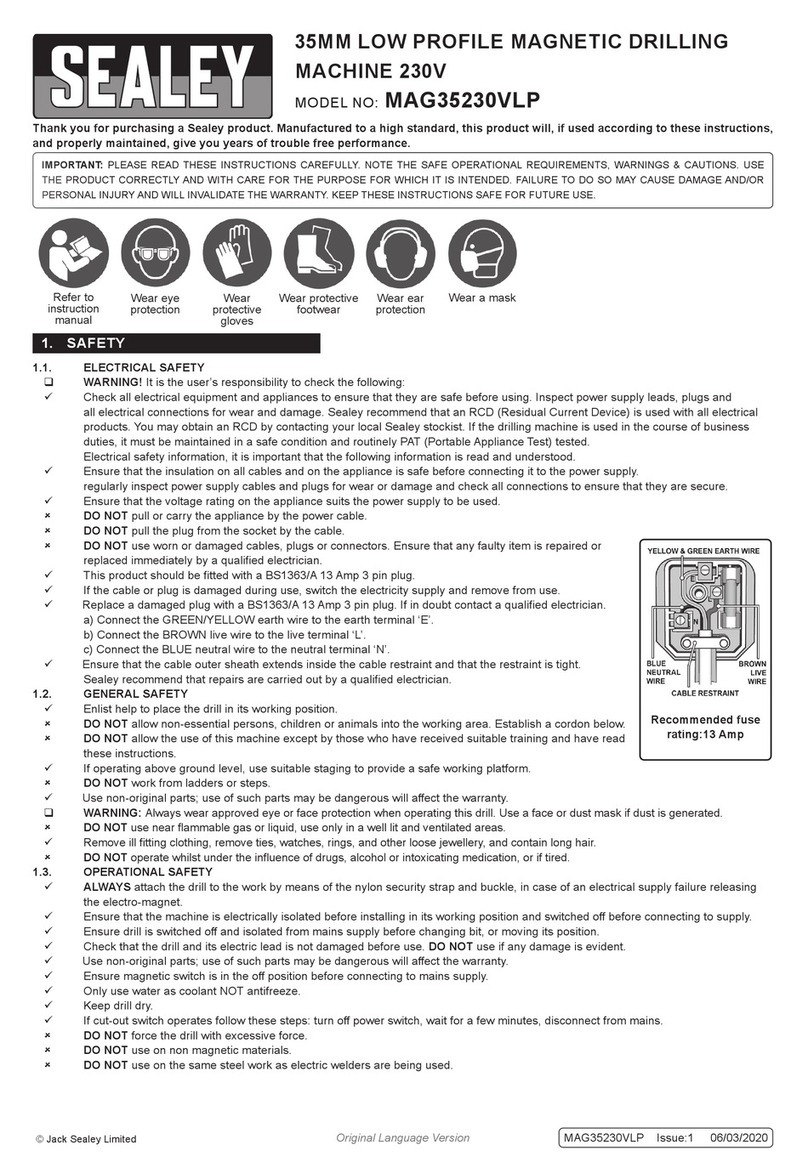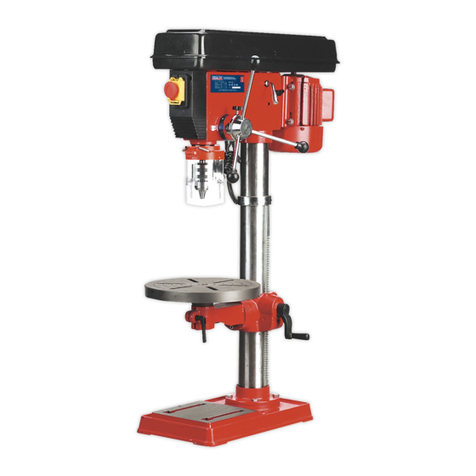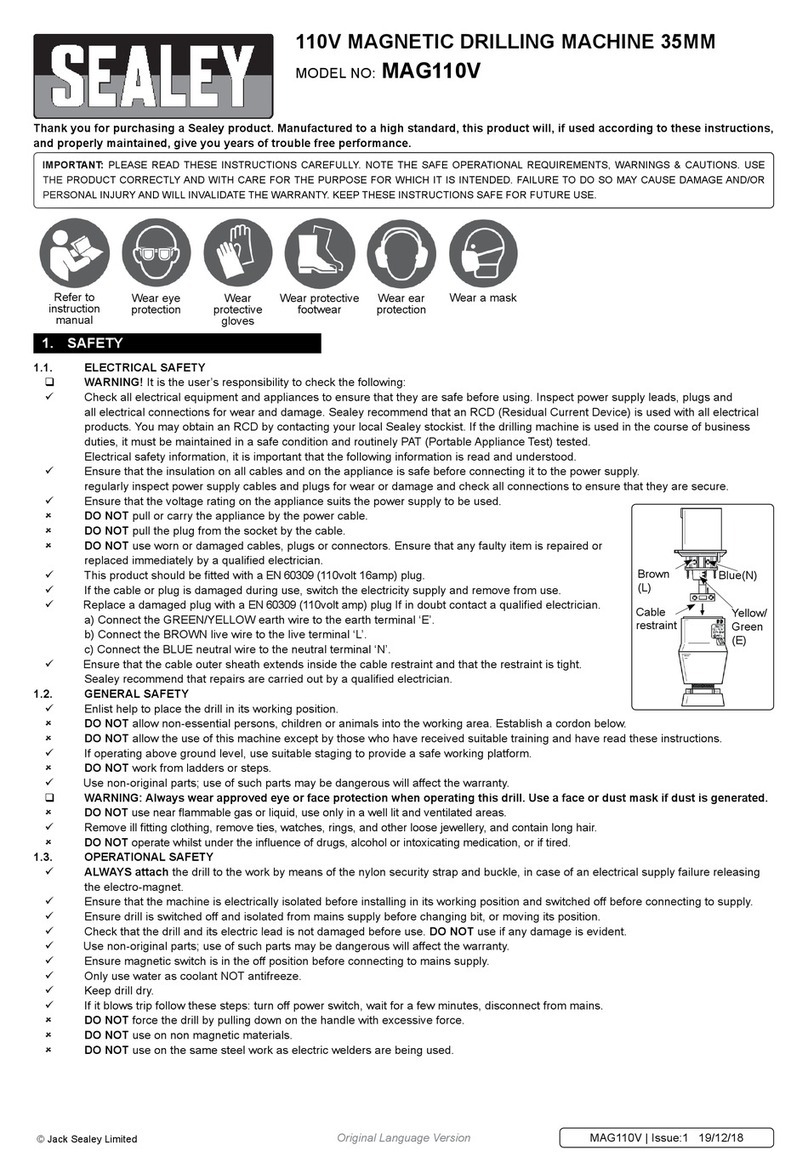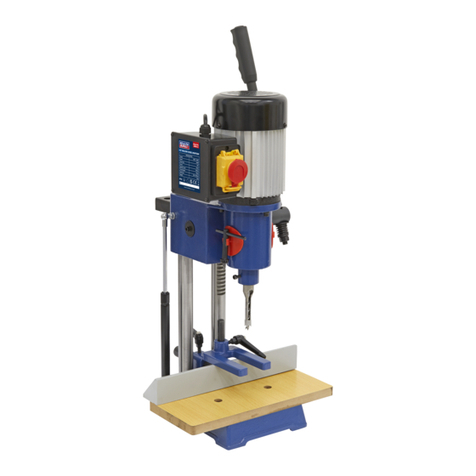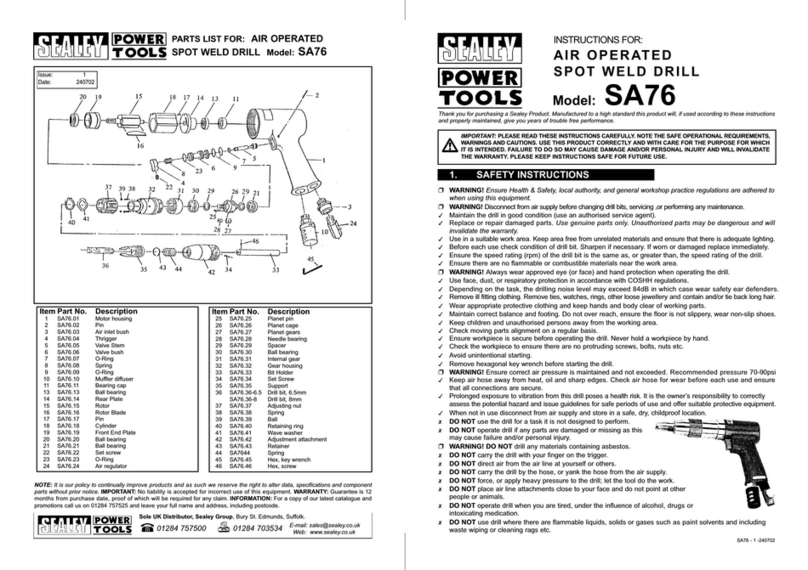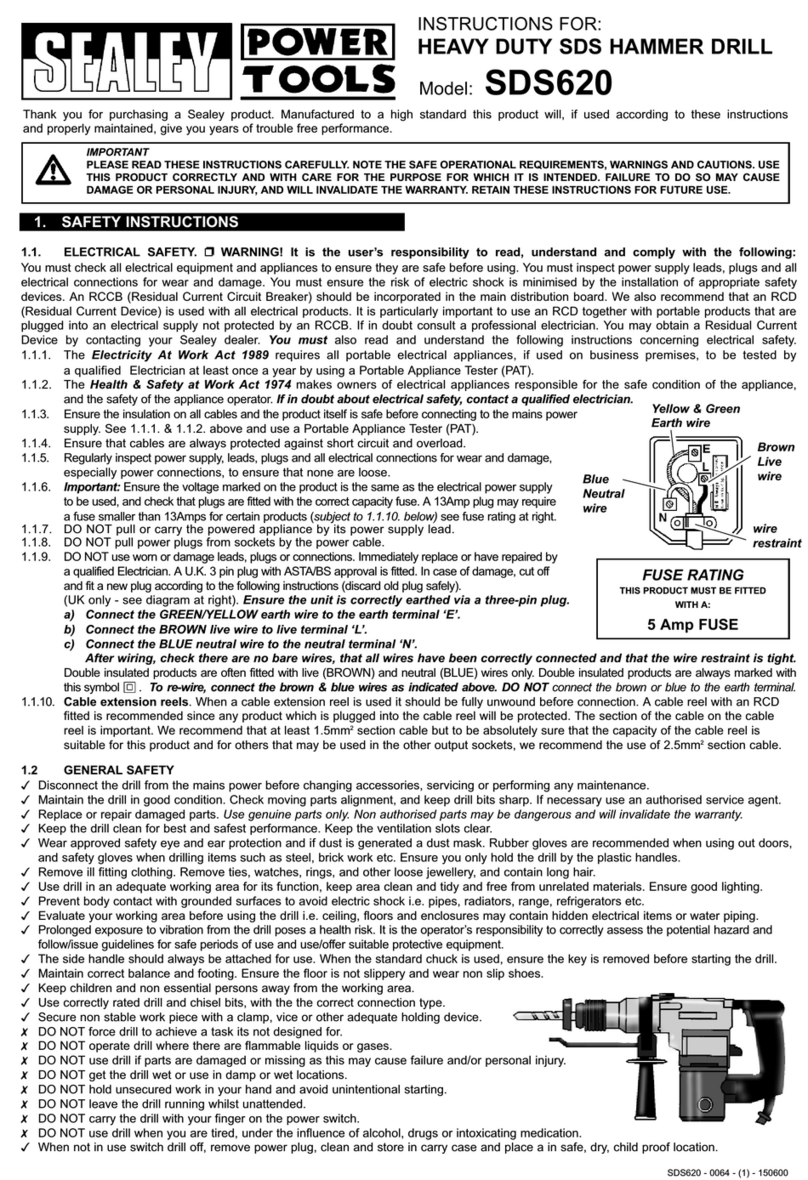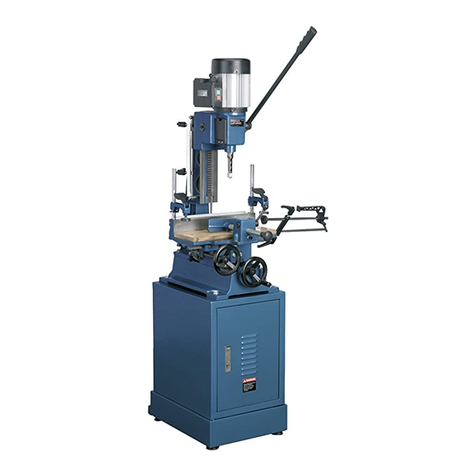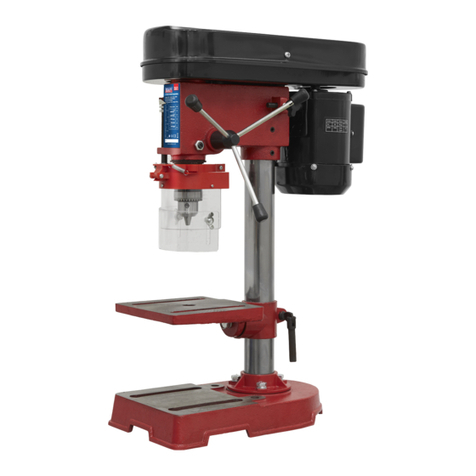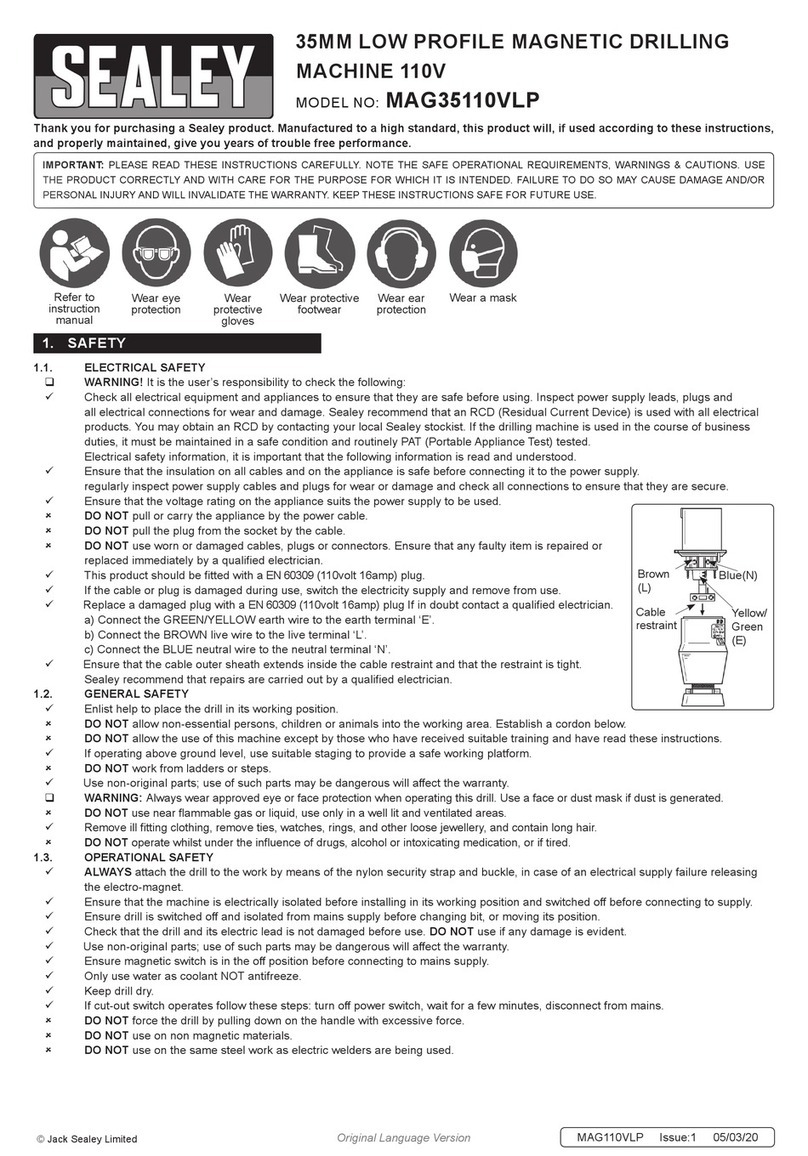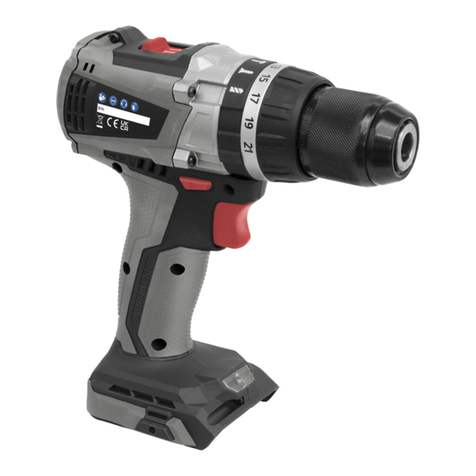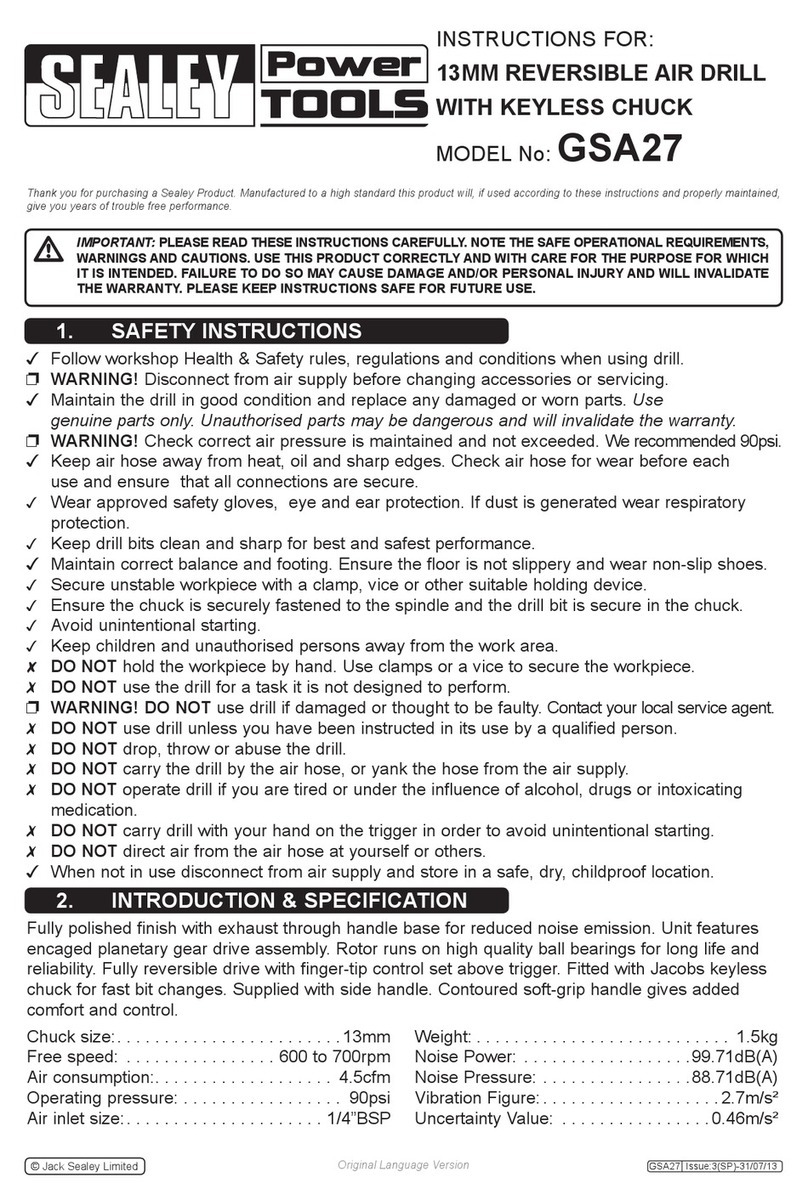
3.2. USING THE DRILL (Ensure you read, understand and comply with Section 1 safety instructions)
p
p
p
WARNING! Always wear approved safety glasses when drilling.
3.2.1. Check the drill to ensure the direction switch (fig.1.6), immediately above the trigger (fig.1.7), is in the mid (locked) position.
3.2.2. Open the chuck by holding the rear collar (fig.3.C) and turning the front chuck collar (fig 3.D), see direction arrow on chuck.
3.2.3. Insert the required bit into the chuck and tighten front collar until locking click is felt and heard.
3.2.4. Press the direction switch (fig.1.6) to the left for clockwise rotation or to the right for anti-clockwise rotation.
3.2.5. Select high or low speed range (fig.1.3), to suit the work.
Note: Operate direction switch and speed range switch ONLY when the drill chuck is stationary, otherwise gearbox may be damaged.
3.2.6. The speed of the drill is controlled by the variable speed trigger (fig.1.7). Squeeze gently for slow speed and progressively increase
the pressure on the trigger to produce correspondingly higher speeds.
3.2.7. Torque setting
The torque is the amount of turning effort applied by the drill. When using the drill as a screw driver or when tightening nuts and
bolts the torque can be set. Torque setting 1 on the collar (fig.3.B) is the lowest setting and will apply the least effort to the final turns
of a screw, etc. The torque becomes progressively greater up to the maximum setting of 8. Note that with the torque setting collar in the
Drill or Hammer positions the clutch is locked and full torque is applied to the bit. Align the required setting with the pointer (fig.3.A) on
the housing.
3.2.8. Screw driving
Lock appropriate tool bit in the chuck. Select the shortest length bit possible to ensure greatest control. You may first need to drill a small
pilot hole to ease the path of the screw, especially in hard materials. Set a low torque and proceed with the task, gradually increasing
the torque if necessary.
To remove screws, bolts, etc, push direction switch to the right for reverse.
When you have finished working, remove the bit from the chuck, clean drill and bit and store
in the carry case with the direction switch in the mid (locked) position.
3.2.9. Hammer drilling
The hammer action, with a masonry drill bit, is used to assist penetration into concrete, stone
and masonry. To use the hammer function turn the torque setting collar (fig.3.B) to the hammer symbol.
Note: DO NOT shift to the Hammer when the drill is running as this may damage the machine.
p
p
p
WARNING! DO NOT use the hammer function with non-masonry bits as these may
shatter, risking damage and/or injury.
3.2.10. Additional features
The front handle (fig.1.11) provides control of the drill in use. Loosen clamp screw (fig.3.F) and slide handle over front of housing in
the angular position best suited to the work. Firmly tighten the clamp screw.
The depth gauge (fig.3.E) gives accurate and repeatable control over drilling depth. In order to fit, and subsequently to adjust, the
gauge rod it is necessary to loosen the front handle clamp screw (fig.3.F). When the rod position is correct, firmly tighten the clamp screw.
The spirit level (fig.1.5) aids accurate drilling and the LCD (fig. 1.4) shows the battery charge status when the black button is pressed.
3.3. DRILLING
p
p
p
WARNING! Ensure that you read and understand Section 1 safety instructions before using the drill.
3.3.1. If the material to be drilled is free standing it should be secured in a vice or with clamps to keep it from turning as the drill bit rotates.
3.3.2. When drilling metals, use a light oil on the drill bit to keep it from overheating. Oil will prolong the life of the bit and improve the drilling action.
3.3.3. For hard, smooth surfaces use a centre punch to mark the hole location. This will prevent the bit from slipping as your start to drill.
3.3.4. A pilot hole may be necessary to assist the final drill size through the workpiece.
Lock a pilot drill (smaller size drill than the finished hole size) into the chuck. Follow steps 3.3.5 to 3.3.8. below and drill a pilot hole in
the middle of the centre punch mark where the final hole is to be drilled. Insert the final sized bit. Hold drill firmly, place the bit at the
entrance of the pilot hole and drill.
3.3.5. Hold tool firmly and place the bit tip at the point to be drilled.
3.3.6. Depress the trigger to start drill. Move the drill bit into the workpiece applying only enough pressure to keep the bit cutting.
DO NOT force the drill bit or apply side pressure to elongate the hole.
3.3.7. Regularly withdraw the drill bit from the hole in order to clear waste material.
3.3.8. Ease the pressure of drilling when the drill is about to break-through the far side of the workpiece.
p
p
p
WARNING! Be prepared for drill binding or break-through. When these situations occur the drill bit may grab and the drill will kick in the
opposite direction and could cause loss of control. If you are not prepared, this loss of control can result in damage and/or personal injury.
3.3.9. If the bit jams in the workpiece or if the drill stalls, release the trigger switch immediately. Operate the drill in reverse to assist release of the bit.
3.3.10. After working for lengthy periods of time, allow the drill to run for approximately 3 minutes with no load, at highest speed, to cool.
3.4. WORK COMPLETE
p
p
p
WARNING! Drill bits become very hot during use. Allow to cool or hold with a cloth for removal.
3.4.1. When you have finished working, remove bit from chuck, clean drill, clean, and if necessary sharpen, bit and store in a safe, dry, childproof area.
3.4.2. Cleaning - Keep drill ventilation slots clean and free from obstruction. If available, blow compressed air into the vents to clear any internal dust
(safety goggles must be worn). Keep the outer case of the drill clean but DO NOT wash with water or use solvents or abrasives.
CP2024VHK - 0064 - (1) - 240401
Declaration of Conformity We, the sole importer into the UK, declare that the products listed here are in conformity with the following standards and directives.
The construction files for these products are held by the Manufacturer and may be inspected, by a national authority,
upon request to Jack Sealey Ltd. For Jack Sealey Ltd.
Sole importer into the UK
of Sealey Power Tools.
24V Cordless Hammer Drill & Battery Charger
Model: CP2024VHK
73/23/EEC L V Directive
89/336/EEC EMC Directive Signed by Mark Sweetman Date 26th April 2001
01284 757500
E-mail:
sales@sealey.co.uk
01284 703534
Sole UK Distributor,
Sealey Group,
Bury St. Edmunds, Suffolk.
NOTE: It is our policy to continually improve products and as such we reserve the right to alter data, specifications and component parts without prior notice.
IMPORTANT: No responsibility is accepted for incorrect use of this product.
WARRANTY: Guarantee is 12 months from purchase date, proof of which will be required for any claim.
INFORMATION: For a copy of our latest catalogue and promotions call us on 01284 757525 and leave your name and address, including post code.
fig. 3
